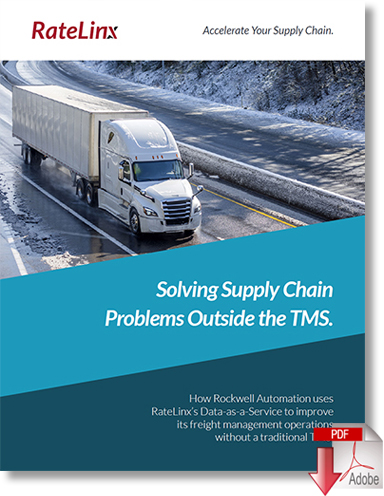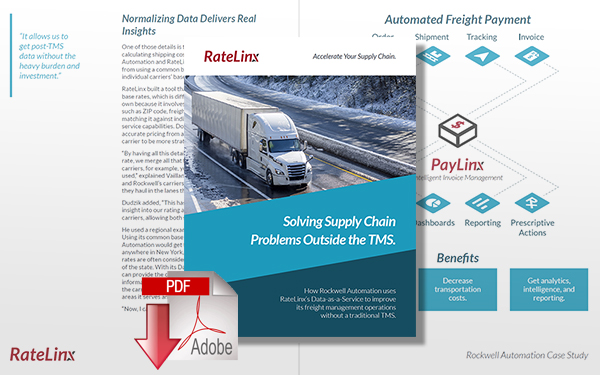Integrating Data Streams Improves Retail Supply Chains

The retail industry is looking to consolidate data sources and systems to accelerate data availability, processing, and strategy deployment.
Consolidating Data Sources
Unrelenting customer demands for faster shipping and continuing growth in e-commerce make it even more critical for retail logistics managers to plan deliveries strategically.
Tight shipping capacity is driving retailers to change as they fight to be a ‘shipper of choice’ with current carriers who can prioritize companies to which they want to provide capacity.
As a result, retailers are looking to supply chain data for strategy development and measuring performance.
However, disparate systems have created silos of information, requiring manual processes to acquire, process or analyze data.
As a result, the retail industry is looking to consolidate data sources and systems to accelerate data availability, processing, and strategy deployment.
Big Supply Chain Data, Bigger Data Challenges
Many companies opt to create a data lake within an internal IT project.
However, IT often cannot cleanse and normalize logistics data from so many different sources.
With the sheer volume of data, it’s impossible to extract any intelligence without cleansing the data first.
There are solution providers for all three streams of shipping, tracking and payment data, and they each focus on their piece.
Transportation Management System (TMS) providers focus on the shipment record and ensuring that carriers are fulfilling their capacity promise through the measurement of tender acceptance.
Track & Trace providers concentrate on the in-transit and delivery information through the measurement of exceptions and on-time deliveries.
Freight audit providers focus on adherence to the contracts through the number of adjustments/short pays. Some providers offer two of the three pieces and may provide increased efficiencies with their solution.
The challenge for shippers and solution providers is matching invoice data to shipping orders and track and trace data.
Often, invoices won’t match precisely to the original order, causing exceptions. Thus, shippers become dependent on their freight payment provider to reconcile exceptions. And without access to the cost-stream, true efficiencies in lanes, modes, and routes can’t be truly determined.
Strategic Advantage Through Integrated Data
Shippers find the real strategic advantage by integrating all three data streams. By cleansing and normalizing supply chain data, retailers can begin to diagnose real problems, develop and validate cost-saving strategies.
After ensuring the strategy works, they deploy, measure and monitor results in real-time. This level of intelligence and strategy enables retailers to improve relationships with their carriers and become a shipper of choice.
Retailers can root cause any failures on behalf of the carrier or internal processes.
Logistics data helps answer several questions:
- Was the carrier paid on time and at the right amount?
- If late deliveries occur, what was the real cause?
- Was the pickup late?
- Did an exception occur?
- Did the carrier have to spend extra time loading or unloading the shipment?
When it comes to carrier compliance issues and cost management, an integrated data platform makes it easy to see the whole picture. By analyzing the shipment records, retailers can determine the service requested and timing.
The track and trace record details the carrier’s performance and any exceptions that may have occurred, such as missed pick-ups or late deliveries.
With all three pieces on one platform, the invoice shows the financial impact of the service provided by the carrier. It empowers retailers to determine which carriers to use and when, optimizing modes, lanes, routes, and carriers.
Integrating logistics data streams makes it easy to diagnose the root cause of an issue because the complete picture is provided by the integration of all three sets.
Building analytics and reporting on top of this cleanly combined dataset allow true and accurate optimizations of logistics and supply chain.
About the Author
Shannon Vaillancourt is president and founder of RateLinx. He started the company in 2002 with the idea that there was a better way to give companies complete visibility to their supply chain. Since then, RateLinx has become a leading supply chain software and data services company with the only integrated Data-as-a-Service (DaaS) technology platform. RateLinx allows companies to gain access to the right data to create a world-class logistics strategy, improve supply chain management, solve problems and reduce costs.
Related Article: Using SWOT Analysis to Prepare Your 2020 Supply Chain Technology Strategy
Case Study Paper
Solving Supply Chain Problems Outside the TMS
In this case study paper, we detail how Rockwell Automation uses RateLinx’s Data-as-a-Service to improve its freight management operations without a traditional transportation management system. Download Now!
More from RateLinx
Article Topics
RateLinx News & Resources
Optimizing Parcel Spend with Reveel and Ratelinx Improving Your Logistics Carrier Request for Proposal Process Focusing on Transportation Costs Instead of Manually Resolving Freight Exceptions Improving Customer Service Through Freight Spend Visibility 5 Reasons Your Logistics Cost-Savings Initiatives Are Suffering Integrating Data Streams Improves Retail Supply Chains Using SWOT Analysis to Prepare Your 2020 Supply Chain Technology Strategy More RateLinxLatest in Technology
Biden Gives Samsung $6.4 Billion For Texas Semiconductor Plants Apple Overtaken as World’s Largest Phone Seller Walmart Unleashes Autonomous Lift Trucks at Four High-Tech DCs Talking Supply Chain: Procurement and the AI revolution 80% of Companies Still Unsure How to Best Leverage AI, Study Finds Supply Chain Stability Index: “Tremendous Improvement” in 2023 AI Not a Priority for Retailers and CPG Companies More Technology















